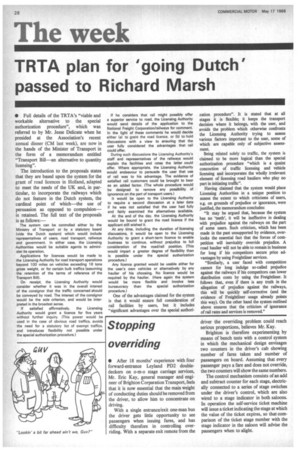Stopping overriding
Page 30

If you've noticed an error in this article please click here to report it so we can fix it.
• After 18 months' experience with four forward-entrance Leyland PD2 doubledeckers on o-m-o stage carriage services, Mr. Eric Kay, general manager and engineer of Brighton Corporation Transport, feels that it is now essential that the main weight of conducting duties should be removed from the driver, to allow him to concentrate on driving.
With a single entrance/exit one-man bus the driver gets little opportunity to see passengers when issuing fares, and has difficulty therefore in controlling overriding. With a separate exit remote from the driver the overriding problem could reach serious proportions, believes Mr. Kay.
Brighton is therefore experimenting by means of bench tests with a control system in which the mechanical design envisages two counters in the driver's cab showing number of fares taken and number of passengers on board. Assuming that every passenger pays a fare and does not override, the two counters will show the same numbers.
The control mechanism consists of an add and subtract counter for each stage, electrically connected to a series of stage switches under the driver's control, which are also wired to a stage indicator in both saloons. In operation the self-service ticket machine will issue a ticket indicating the stage at which the value of the ticket expires, so that comparison of the ticket stage number with the stage indicator in the saloon will advise the passengers when to alight.




























































































































